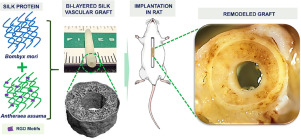当前位置:
X-MOL 学术
›
Acta Biomater.
›
论文详情
Our official English website, www.x-mol.net, welcomes your
feedback! (Note: you will need to create a separate account there.)
Bioresorbable silk grafts for small diameter vascular tissue engineering applications: In vitro and in vivo functional analysis.
Acta Biomaterialia ( IF 9.4 ) Pub Date : 2020-01-17 , DOI: 10.1016/j.actbio.2020.01.020 Prerak Gupta 1 , Katherine L Lorentz 2 , Darren G Haskett 3 , Eoghan M Cunnane 4 , Aneesh K Ramaswamy 2 , Justin S Weinbaum 5 , David A Vorp 6 , Biman B Mandal 7
Acta Biomaterialia ( IF 9.4 ) Pub Date : 2020-01-17 , DOI: 10.1016/j.actbio.2020.01.020 Prerak Gupta 1 , Katherine L Lorentz 2 , Darren G Haskett 3 , Eoghan M Cunnane 4 , Aneesh K Ramaswamy 2 , Justin S Weinbaum 5 , David A Vorp 6 , Biman B Mandal 7
Affiliation

|
The success of tissue-engineered vascular graft (TEVG) predominantly relies on the selection of a suitable biomaterial and graft design. Natural biopolymer silk has shown great promise for various tissue-engineering applications. This study is the first to investigate Indian endemic non-mulberry silk (Antheraea assama-AA) - which inherits naturally superior mechanical and biological traits (e.g., RGD motifs) compared to Bombyx mori-BM silk, for TEVG applications. We designed bi-layered biomimetic small diameter AA-BM silk TEVGs adopting a new fabrication methodology. The inner layer showed ideally sized (~40 µm) pores with interconnectivity to allow cellular infiltration, and an outer dense electrospun layer that confers mechanical resilience. Biodegradation of silk TEVGs into amino acids as resorbable byproducts corroborates their in vivo remodeling ability. Following our previous reports, we surgically implanted human adipose tissue-derived stromal vascular fraction (SVF) seeded silk TEVGs in Lewis rats as abdominal aortic interposition grafts for 8 weeks. Adequate suture retention strength (0.45 ± 0.1 N) without any blood seepage post-implantation substantiate the grafts' viability. AA silk-based TEVGs showed superior animal survival and graft patency compared to BM silk TEVGs. Histological analysis revealed neo-tissue formation, host cell infiltration and graft remodeling in terms of extracellular matrix turnover. Altogether, this study demonstrates promising aspects of AA silk TEVGs for vascular tissue engineering applications. STATEMENT OF SIGNIFICANCE: Clinical 'off the shelf' implementation of tissue-engineered vascular grafts (TEVGs) remains a challenge. Achieving optimal blood vessel regeneration requires the use of bioresorbable materials having suitable degradation rates while producing minimal or no toxic byproducts. Host cell recruitment and preventing acute thrombosis are other pre-requisites for successful graft remodeling. In this study, for the first time we explored the use of naturally derived Indian endemic non-mulberry Antheraea assama silk in combination with Bombyx mori silk for TEVG applications by adopting a new biomimetic approach. Our bi-layered silk TEVGs were optimally porous, mechanically resilient and biodegradable. In vivo implantation in rat aorta showed long-term patency and graft remodeling by host cell infiltration and extracellular matrix deposition corroborating their clinical feasibility.
中文翻译:

用于小直径血管组织工程应用的生物可吸收丝移植物:体外和体内功能分析。
组织工程血管移植物(TEVG)的成功主要取决于选择合适的生物材料和移植物设计。天然生物聚合物丝在各种组织工程应用中显示出巨大的前景。这项研究首次调查了印度特有的非桑蚕丝(Antheraea assama-AA),与 Bombyx mori-BM 丝相比,它继承了天然优越的机械和生物特性(例如 RGD 图案),用于 TEVG 应用。我们采用新的制造方法设计了双层仿生小直径 AA-BM 丝 TEVG。内层显示出理想尺寸(约 40 µm)的孔隙,具有互连性,允许细胞渗透,外层致密电纺层具有机械弹性。丝 TEVG 生物降解为氨基酸作为可吸收副产物,证实了它们的体内重塑能力。根据我们之前的报告,我们通过手术将人类脂肪组织来源的基质血管成分(SVF)接种的丝 TEVG 作为腹主动脉介入移植物植入 Lewis 大鼠体内,持续 8 周。足够的缝合线保持强度(0.45 ± 0.1 N),植入后无任何血液渗漏,证实了移植物的活力。与 BM 丝 TEVG 相比,AA 丝基 TEVG 表现出优异的动物存活率和移植物通畅性。组织学分析揭示了新组织形成、宿主细胞浸润和细胞外基质周转方面的移植物重塑。总而言之,这项研究证明了 AA 丝 TEVG 在血管组织工程应用中的前景。意义声明:组织工程血管移植物(TEVG)的临床“现成”实施仍然是一个挑战。 实现最佳的血管再生需要使用具有合适降解率的生物可吸收材料,同时产生最少或不产生有毒副产物。宿主细胞募集和预防急性血栓形成是移植物重塑成功的其他先决条件。在这项研究中,我们首次通过采用新的仿生方法探索将天然来源的印度特有非桑蚕丝与家蚕丝结合用于 TEVG 应用。我们的双层丝 TEVG 具有最佳的多孔性、机械弹性和可生物降解性。大鼠主动脉体内植入显示出长期通畅,并通过宿主细胞浸润和细胞外基质沉积进行移植物重塑,证实了其临床可行性。
更新日期:2020-01-17
中文翻译:

用于小直径血管组织工程应用的生物可吸收丝移植物:体外和体内功能分析。
组织工程血管移植物(TEVG)的成功主要取决于选择合适的生物材料和移植物设计。天然生物聚合物丝在各种组织工程应用中显示出巨大的前景。这项研究首次调查了印度特有的非桑蚕丝(Antheraea assama-AA),与 Bombyx mori-BM 丝相比,它继承了天然优越的机械和生物特性(例如 RGD 图案),用于 TEVG 应用。我们采用新的制造方法设计了双层仿生小直径 AA-BM 丝 TEVG。内层显示出理想尺寸(约 40 µm)的孔隙,具有互连性,允许细胞渗透,外层致密电纺层具有机械弹性。丝 TEVG 生物降解为氨基酸作为可吸收副产物,证实了它们的体内重塑能力。根据我们之前的报告,我们通过手术将人类脂肪组织来源的基质血管成分(SVF)接种的丝 TEVG 作为腹主动脉介入移植物植入 Lewis 大鼠体内,持续 8 周。足够的缝合线保持强度(0.45 ± 0.1 N),植入后无任何血液渗漏,证实了移植物的活力。与 BM 丝 TEVG 相比,AA 丝基 TEVG 表现出优异的动物存活率和移植物通畅性。组织学分析揭示了新组织形成、宿主细胞浸润和细胞外基质周转方面的移植物重塑。总而言之,这项研究证明了 AA 丝 TEVG 在血管组织工程应用中的前景。意义声明:组织工程血管移植物(TEVG)的临床“现成”实施仍然是一个挑战。 实现最佳的血管再生需要使用具有合适降解率的生物可吸收材料,同时产生最少或不产生有毒副产物。宿主细胞募集和预防急性血栓形成是移植物重塑成功的其他先决条件。在这项研究中,我们首次通过采用新的仿生方法探索将天然来源的印度特有非桑蚕丝与家蚕丝结合用于 TEVG 应用。我们的双层丝 TEVG 具有最佳的多孔性、机械弹性和可生物降解性。大鼠主动脉体内植入显示出长期通畅,并通过宿主细胞浸润和细胞外基质沉积进行移植物重塑,证实了其临床可行性。









































 京公网安备 11010802027423号
京公网安备 11010802027423号